Art is a symbolic communicative behaviour only practiced by humans. It is generally believed that this art has evolved concurrently with other cultural traits such as language, symbolism, self-consciousness, neural evolution and hence becomes an important source to understand the beginning of human intellect and ability of the human species to produce abstractions of reality. The early artistic abilities of man across the world are preserved on the hard and solid rock surfaces termed as rock art. Rock art is a global phenomenon and this creative genius of the prehistoric man is manifested in almost every part of the world, in different techniques and styles, reflecting different themes specific to different cultural periods.
Robert G. Bednarik defines rock art as artistic manifestation or markings that were intentionally produced by human beings on rock. This art form is generally manifested inside rock shelters, large overhangs, caves and caverns as well as on the surface of large boulders and many a time on bedrock. Iconic and un-iconic motifs covering varied themes are generally exemplified in numerous techniques such as engravings, paintings, drawings, prints, stencils, carvings in bas-relief.
Fortunately, Indian subcontinent is enormously rich in rock art legacy. This primeval heritage has abundantly encompassed glimpses of cognitive and cultural behaviours of primordial societies that are exemplified in various styles and techniques, covering varied subjects through time. No one knows the exact meaning of most of the rock art, but, at the same time, it is also true as Robert G. Bednarik explains “that it is the outcome of human thought, associated with and influenced by the beliefs, artistic conventions, cognitive and cultural behaviours as well as the awareness of the artist to some form of reality”.
Aesthetics is considered an important reason for the manifestation of art. Besides this, art also serves the purpose of recording and narrating an event or a story, or an important method of teaching and preaching in societies where an alphabet has no meaning. It can be used as an important tool for the performance of magico-religious and ceremonial practices, and furthermore, it can be utilised as an instrument of encouragement or warning to an individual, group or society, whether contemporary or for the coming generations, or else it can be just an exemplification of some ethical or metaphysical idea. Therefore, it can be assumed that rock art might have served at least one or all of these purposes among preliterate societies.
Whatever be the purpose of rock art, whether to describe the beauty and importance of contemporary natural surroundings, the material and non-material culture or the representation of an abstract idea, in all such cases, one can deduce with certainty that it is an indication of a highly developed sense of human perception and cognition.
The Earliest Prehistoric artistic icons and art objects
Various prehistoric artistic icons and art objects that have been reported from India are some of the world’s earliest artistic manifestations. These are in form of cupules or cup marks (small circular depressions in stone) that have been found at sites like Bhimbetka and Darki Chattan (fig.1 and 2) etc. dated to 700,000 to 200,000 years. In addition to this, a few very important prehistoric finds in form of hematite nodule from the Acheulian horizon of Hunsgi Valley (Karnataka) and quartz crystals that were imported to the site by the prehistoric man from a distant place just for its geometrical qualities have been recovered from the Lower Palaeolithic horizons of Didwana (Nagaur, Rajasthan). Other objects are in form of a circular disc from the Lower Palaeolithic levels of Bhimbetka, district Raisen and a similar stone disc from Maihar in Satna district, both in Madhya Pradesh. These Middle Pleistocene finds (781,000 to 126,000 years) were possibly manifested by one or the other species of archaic humans who lived in vast Dry-semi-arid climate that supported short or scrubby vegetation dominated by grasses and shrubs.
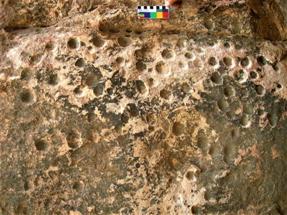
Figure 1: Cupules manifested on the walls of the cave of Darki Chattan, Lower Palaeolithic Period, Mandasaur, Madhya Pradesh
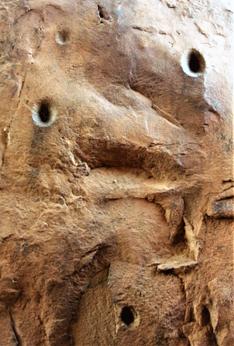
Figure 2: Cupules on the walls of Auditorium cave, Lower Palaeolithic Period, Bhimbetka, Madhya Pradesh
By about 60,000 years ago modern humans entered India from Africa and in a short span of time occupied different parts of the subcontinent which was then mostly a vast tropical grassland. This was the period when the ostrich bird also entered India. This is testimonied by the findings of hundreds of ostrich eggshell pieces that have been recovered from various sites of western India. This region was then partly experiencing a topical extreme desert climate and part of it was tropical semi-desert. It is a popular belief that various large mammals including various species of elephants, hippopotamus, cattle, buffalo and Palaeoloxodon namadicus, or the Asian straight-tusked elephant (largest land mammal on record) became extinct due to intense arid and dry climate. The archaeological remains of this phase that are mostly in form of small stone tools, rubber stones for food processing, charred bones have been noticed at various sites either located along small and large rivers or inside caves and rock shelters. Among the important findings, the discovery of dozens of art objects in form of engraved core (Figure 3), ostrich eggshell beads, and engraved ostrich shell pieces found in Central and Western India are most noteworthy. These finds demonstrate an advanced aesthetic sense of Late Pleistocene humans in the Indian Subcontinent. Other than these art objects, many of the un-iconic and iconic figures of the Upper Palaeolithic period are also found manifested on rock in the form of paintings and engravings.
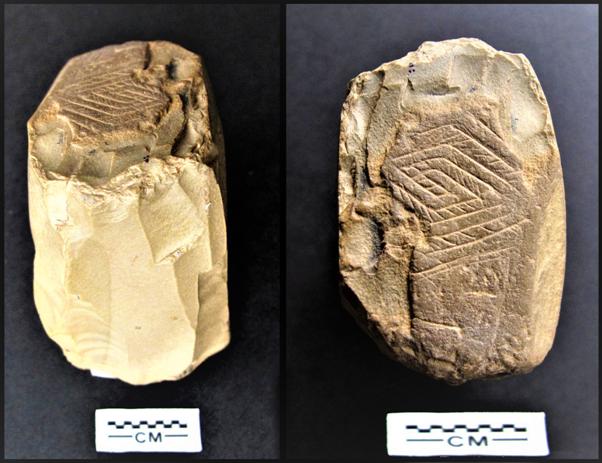
Figure 3 Engraved Cross Hatched Diamond-shaped design on the Fluted Core, Upper Palaeolithic/Mesolithic Period, Chandravati, Rajasthan (Courtesy: Prof. V.H. Sonawane)
With the end of the ice age, around 11000 years ago at the start of the Holocene epoch, the earth started witnessing warmer and a humid climate. This lead to increased monsoonal rains that permitted an extensive spread of moist savannah-type vegetation in India replacing the dry savannah or arid grasslands. This not only helped in extending the forest cover and grasslands but had also amazingly diversified the life on the planet. Culturally this phase is known as the Mesolithic period or the stage between the Palaeolithic and Neolithic. Due to abundant flora and fauna, hunters thrived in this period. This was the final phase of hunters just before the Neolithic revolution took place. The most significant feature of this phase was the use of an advanced tool kit, exemplification of complex and sophisticated art, and transition process from the hunting-gathering way of life- to farming and animal domestication. During this period among all the rock art zones or regions, the emphasis was given to draw the elaborate hunting and gathering scenes (fig. 4 to 7). In all these scenes emphasis was given to the main subject of the activity which were usually animal forms such as deer, antelopes, and wild boar along with some minor scenes such as the depiction of hunters equipped with multi-barbed arrow and bow, lance and some holding traps. Further, animals like monkey, elephant, and rhinoceros are profusely depicted in this period (fig. 8). Other scenes include family life, dance as well as digging of rat holes, honey collection and use of digging sticks, traps and nets for foraging and hunting activities as well as mythical and defied animals and therianthromorphs and some ancestral beings (fig. 9).

Figure 4: Mesolithic human and animal forms painted inside the rock shelters of Chaturbhujnath Nala, district Mandasaur, Madhya Pradesh

Figure 5: Wild boar hunting scene, Mesolithic Period, Bhimbetka, Raisen district, Madhya Pradesh

Figure 6: Hunting of big game, Mesolithic Period, Lakhajwar, Raisen, Madhya Pradesh
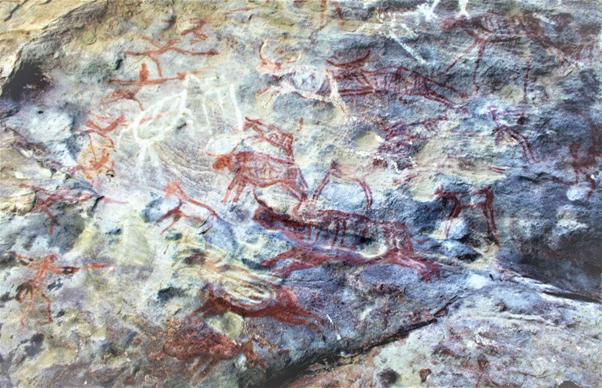
Figure 7: Hunting of wild animals, Mesolithic Period, Urdain, Raisen district, Madhya Pradesh
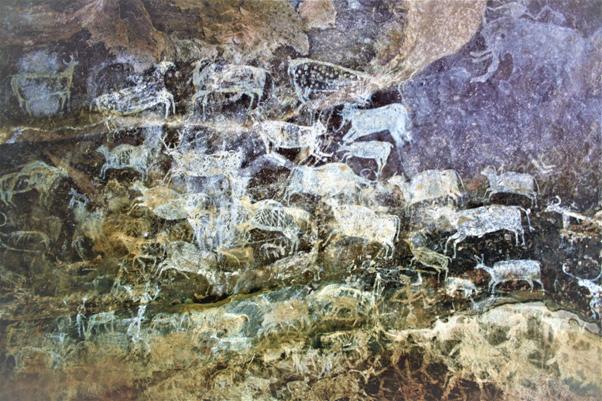
Figure 8: A painted wild herd of animals, Mesolithic, Bhimbetka, Raisen district, Madhya Pradesh
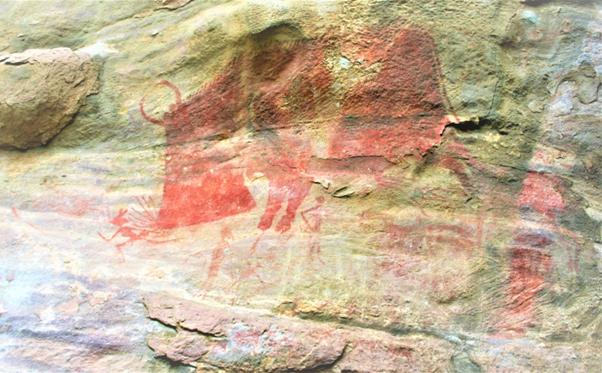
Figure 9: Mythical composite animal, Mesolithic Period, Bhimbetka, Raisen district, Madhya Pradesh
Almost all over the Indian subcontinent depictions belonging to this period are closer to nature and most of the themes are related to the life of a simple hunting-gathering society or in form of abstract designs and patterns and bear thematic similarities as well as parallels in style. Mesolithic art is deer centric (fig. 10) and humans are commonly found involved in hunting and in recreational activities such as dance. They are generally painted in simple lines or in outlines with resilient and athletic body movements. Many a time’s human forms are found adorned with numerous types of headgears and lower body garments such as lion’s cloth (fig. 11, 12 and 13). The characteristic features of this phase are the balanced and proportionate bodies as well as the elegant and dynamic body movements of animals. The Mesolithic folks used various styles to depict motifs but outlined figures with natural body contours and posture was the most common style of this period. At times, stylized portraitures of animals were also executed. The bodies of most of the painted animals in this period were decorated with linear and curvilinear abstract patterns and designs. X-ray depiction portraying organs such as oesophagus/windpipe, heart, lungs, intestine, ribs, and foetus inside the animal body was an important style of this period that is seen in one or the other forms in most of the Mesolithic depictions all over India (fig. 14 and 15). In the final Mesolithic period, the animals have lost dynamism and elegance in movement but the bodies remained as lively and beautiful as before. These artistic manifestations suggest that these were work of specialized groups/individuals who had executed them probably on some important occasions or events.
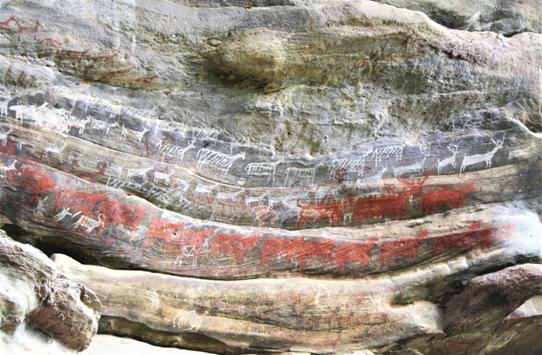
Figure 10: A herd of deer painted in red and white colour, Late Mesolithic Period, Kathotia, Raisen district, Madhya Pradesh
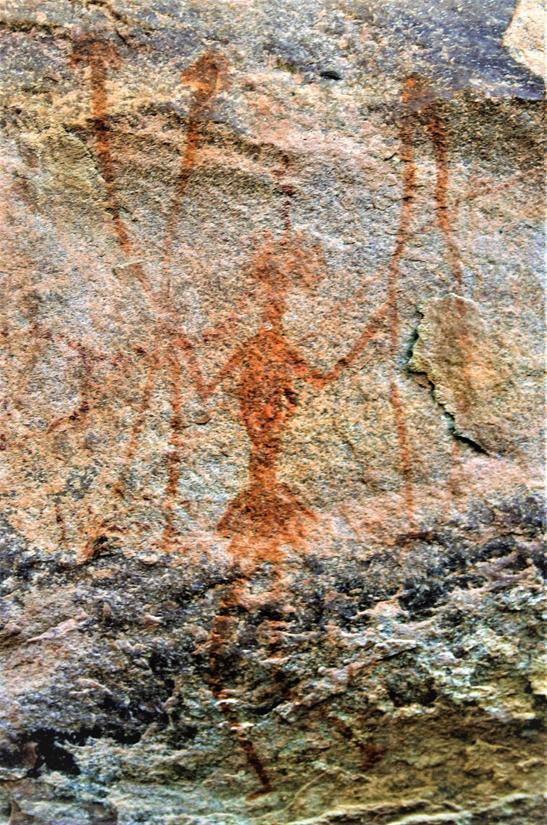
Figure 11: Mesolithic hunter with upraised bow and arrow, Lakhajwar, Raisen district, Madhya Pradesh
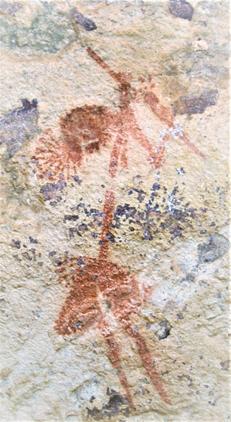
Figure 12: A Mesolithic human form with a sac and stick depicted with a dynamic stick-shaped body, Lakhajwar, Raisen district, Madhya Pradesh

Figure 13
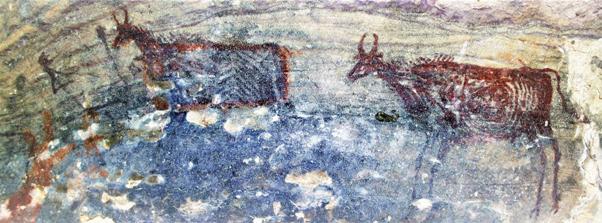
Figure 14: Mesolithic theme depicting a pair of Nilgai, (the largest Asian antelope) painted in outlines filled in with geometrical patterns, Pengawan, Raisen district, Madhya Pradesh

Figure 15: Animal herds painted in different styles, Mesolithic Period, Ramchajja, Raisen district, Madhya Pradesh
Recently a few direct dating methods have been applied on a few painted depictions of Adamgarh which have yielded the dates of paintings to about fourth millennium B.C. Excavations conducted at various rock shelter sites such as Modi, Bhimbetka, Adamgarh have yielded hematite nodules (at times faceted) from the Early and late Mesolithic layers. These layers are dated to around 7500 to 4000 B. P.
The Rock Art of Pastoral Nomads and Agriculturists: In the Chalcolithic/Neolithic phase a new element “cattle” occupies a major space of most of the art panels and it looks as if the life of Neolithic man was revolving around this bovid. Whether social life or economic life, cattle becomes an ubiquitous beast. Scenes related to pastoralism and herding are one of the most portrayed scenes in the rock art of this period. This animal is portrayed in large herds with the herdsmen, in chariots and carts, yoked with a ploughshare, in large cow pens, fasten with pegs, in milking activity, etc. are the most common scenes associated with this animal. Other rock art scenes include metallic axe wielders, cattle riders, drummers, dancers, and hunters (fig.16 to 20). By this period cattle was so much so part of the human life that its portraitures are even reflected in the plastic art in form of bull motifs on pottery, terracotta bull figures, on seals, sealing's, etc. It appears that by and large during this phase in the subcontinent cattle based pastoralism was one of the essential economies and hence it becomes one of the most significant features of rock art of this period.

Figure 16: Chalcolithic theme depicting charioteers bewilding metallic axes, Chaturbhujnath Nala, Mandsaur district, Madhya Pradesh

Figure 17: Cattle mounted human form weilding a battle axe, Chaturbhujnath Nala, Mandsaur district, Madhya Pradesh
In this phase for the first time use of weaponry in the form of metallic axes used by the charioteers and cavillers for offence and defence purposes is manifested at a number of sites. Quite often these axes are even depicted in hunting scenes. In the rock art of Chambal basin, metallic axe wielders are at times painted in standing mode, as charioteers and also as cattle riders. These figures occupy a significant space thereby indicating a transformed social setup from an egalitarian society towards more complex chiefdoms.

Figure 18: Battle axe weilders, cattler and deer, Neolithic Period, Tekkalakota, Bellari district, Karnataka (courtesy: Dr. V. Shobha, Mysore)

Figure 19: A lone horned bull in flat wash, Chatturbhujnath Nala, Mandsaur district, Madhya Pradesh

Figure 20: Tethered cattle being tended by humans, Chaturbhujnath Nala, Mandsaur district, Madhya Pradesh
During the early Neolithic/Chalcolithic phase style of execution of motifs remained a bit influenced by the Mesolithic paintings, but latter the depictions became more static but retained a balanced body proportion and elegance in portraiture. Most of the paintings of this phase are in form of shadowgraph depicted in a silhouette of variants of red and brown colour. Simple outlines and outlines partially filled in with flat wash were widely used to portray the depictions. Figures in outlines had body decoration of linear and curvilinear designs, whereas a part of the depiction was painted in flat wash. Initially, most of the depictions retained naturalism in style, but later the depictions became conventionalized and stereotyped. On the basis of the pictographic similarities of paintings on the pottery of this phase and that of painted depictions of rock art, it can be tentatively put into the time bracket of 3rd and 2nd millennium B. C. in India.
Megalithic Rock Art: After the decline of Indus Valley Civilisation, from 1500 BC onwards some new traits start emerging in the cultural landscapes of the subcontinent in the form of large mortuary grounds located on the barren lands dotted with various types of burial monuments or commemorative (non-sepulchral) memorials such as dolmens, dolmenoid cists (box-shaped stone burial chambers), cairn circles (stone circles with defined peripheries), cairns (mounds of pebbles) and capstones (mushroom-shaped burial chambers) as well as large standing monolithic stones termed as menhirs reflecting the settled life and rise of the political economy. Evidence suggests that these people occupied and settled in fertile valleys and took both the rabi and kharif crops supported by animal raring and supplemented by hunting; had a strong belief in life after death and possibly in rebirth and in the idea of a soul and sacrificed animals. Artifacts reflect a complex society, a well-developed ceramic industry, they manufactured and used iron and copper artefacts, stone beads, gold & silver ornaments, terracotta objects, and a variety of objects of arts. Interestingly, these people also practiced rock art which can be either seen on the memorial monuments as well as inside the caves and on boulders. The boulders of many of the stone circles and the large standing menhirs, as well as the capstones of the dolmens, are many a time marked by linear and random patterns of cup marks, a symbolism unknown to us, however, their placement on boulders of stone circles of Nagpur region reflect preferred directionality towards East and South (Fig 21). In South India, hundreds of rock paintings are discovered in the vicinity of megalithic sites, some of these paintings reflect the symbology and other cultural aspects of Megalithic life. The most important depiction is a painted megalithic grave from Annegundi, district Bellari (Fig 22).

Figure 21:Cupules exemplified on one of the boulders of a stone circle at the Megalithic site of Junapani, Nagpur district, Maharashtra

Figure 22: Painted Megalithic burial, Onake Kindi, near Chikka, Koppal district, Karnataka (Courtesy: Dr. Srikumar M. Menon, Bangalore)
Rock Art of Historical Period: In India, during the Historical Period other than the permanently settled societies, there was a section of people who occupied caves, caverns and rock shelters located in hilly and forested areas. In all such areas, the signatures of their presence is reflected from portraitures such as symbols, deities, battle scenes, hunting scenes, inscriptions, etc., that they have portrayed inside concavities of rocks, rock shelters and on the boulders (Fig. 23 to 27). These manifestations are thematically and stylistically different from those that were painted during the Mesolithic and the Chalcolithic periods. A closer look at the depictions of Historical period suggests that these were possibly the creation of marching army/war refugees who occupied these rock shelters as camps or work of the hermits and saints who transformed the caves, caverns or large overhangs as a place for meditation or worship in the pristine forests and exemplified their beliefs, conception, myths, symbolism and ideology. These caves might have also played a vital role as hunting camps for the royal hunters on horseback (Fig. 28 and 29) as well as for the local medicine man or shamans who executed those symbols, which have some relevance in conducting magical and ceremonial practices. Some of the famous rock shelters sites such as those at Sanchi, Narsinghgarh, Kotra vihar (all in Madhya Pradesh) fall on ancient trade routes and have enough archaeological material inside and in the vicinity of the shelters that suggest that these were once occupied by the monks. Some of these shelters are famous religious centres of the mother goddess. It is noteworthy that many of the manifestations painted inside these shelters have ceremonial and ritualistic significance among the contemporary rural and tribal folks of India. These symbols and decorative patterns continue in the form of wall and floor art in all such areas where shelters bearing early historic rock art are located.

Figure 23: Marching cavalrymen and foot soldiers equipped with weapons of offence and defence, Late Historical, Kathotia, Raisen district, Madhya Pradesh

Figure 24: Marching cavalrymen and foot soldiers equipped with weapons of offence and defence are superimposed on the Mesolithic paintings, Kathotia, Raisen district, Madhya Pradesh
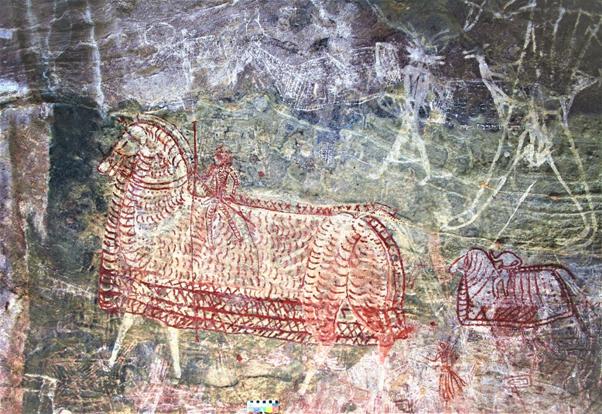
Figure 25: Painted portraiture of a rider mounted on a caparisoned horse, Historical period, Satkunda, Raisen district, Madhya Pradesh

Figure 26: Battle scene depicting cavalry, elephant mount and foot soldiers, Historical Period Kotra Vihar, Rajgarh district, Madhya Pradesh

Figure 27: Decorated rock shelter with stupa symbol and inscription in Brahmi script, Historical Period, Kotra Vihar, Rajgarh district, Madhya Pradesh

Figure 28: Royal hunting scene portraying hunters mounted on horses and camels are accompanied by archers, beaters, drummers and staff bearer, Historical Period, Govindpura, Bundi district, Rajasthan
In India, hundreds of rock art panels preserve the captivating cultural heritage of Historical rock art across the subcontinent. These rocky panels are either in form of spherical surfaces of hundreds of granite boulders found in different geological formations of Laddakh, parts of Northwestern Rajasthan, Gujarat, Karnataka, Tamilnadu and Andhra Pradesh (Rayal Seema). Thousands of cavities, walls and ceilings of overhangs of sandstone and quartzite belts of Central India, Malwa Plateau, Vindhyan range, Aravalli range also houses hundreds of painted and carved motives belonging to this period. These painted motifs vary from symbols to intricate and simple geometrical designs and from animal depictions to human forms. The other characteristic feature of the rock art of this phase is the emergence of inscriptions in Brahmi and shell script. Apart from the hunting scenes and depictions of humans engaged in various socio-cultural activities, battle scenes depicting soldiers mounted on horseback, camel and elephants and accompanied by the cavalrymen equipped with contemporary weapons such as swords, lance, shields, bow and arrow becomes a prominent feature of rock art of this phase. The style in the execution of artistic motifs in the early phase of this period is much influenced by the rock art of Neolithic and Chalcolithic phase, however latter, the motifs became more static and geometrical in shape. Most of the human and animal forms lost dynamism and were portrayed in static form for representational purposes. Contrary to this, inscriptions, intricate designs and symbols were elegantly manifested and the hunting and battle themes retained full naturalism with the element of regional stylisation in portraying horses and humans. New styles and concepts were introduced to rock art and this can be seen at sites like Firengi where depictions showing people dressed in Kaftan-like clothes and sometimes with loose pantaloons can be compared with the Central Asian features and have a parallel in Kushana art. The depiction of Kaftan-like coats and Central Asian caps decorated with long tassels as adornments were found in the early Buddhist sculptures. Most of the historical themes revolve around religion and war. However, at some sites, scenes related to family and social life are depicted. In addition, people engaged in different recreational activities such as dancing, playing string instruments and drums are also portrayed at some of the sites. Portraitures related to economic life are rare, although at some sites economic activities such as ploughing, use of bullock carts, fishing, cattle rearing, hunting with a dog on horseback as well as honey collection is beautifully portrayed at a few sites. Scenes of royal hunt much alike depicted in many of the Mughal miniatures become part of many of the painted surfaces. Activities related to offense and defence are most extensively portrayed themes. Marching fleets of army equipped with weaponry such as swords, daggers, spears, shields, bow and arrow are often shown accompanied by soldiers riding on horses, elephants and camels. For the first time images of gods of Brahmical cult such as Krishna, Balarama (Fig. 30) and Shiva find a place in the rock art. Later multi-armed gods and goddesses were also depicted along with religious motifs of Hindu iconography and mythological characters such as Shravan Kumar. Mortuary practices such as the stone circle; religious structures such as stupa and temples are also depicted at a few sites. The non-iconic art of this phase is mostly in the form of certain signs and symbols such as the swastika, triratna, ashtdal and alpana design that are beautifully manifested (Fig. 31). The other important features of rock art of this phase are floral motifs, geometrical and labyrinthine symbols that have their own relevance (Fig. 32). In this phase, saints and hermits also occupied the shelters; their signatures are seen in the form of certain religious symbols and themes, and inscriptions in Bramhi, Shell and other regional scripts. The enormous data of rock art of historical phase in India suggests that many of the hilly areas possessing liveable areas in the form of rock shelters were utilised as monasteries, chaityas, viharas, and temples. One the basis of religious themes, body decoration of the human forms, and from the paleography of inscriptions, the art of this period may be placed between the fourth century B.C. and to Late Historical period.
After the Historic and Early Mediaeval period, we don't get rock paintings painted on the rocky panels. This does not mean that rock painting tradition came to an end all of a sudden, but instead, it shows that once the forest-dwelling societies acquired more sedentary mode of village life backed by agriculture, this tradition continued in form of wall, palm leaves and cloth painting which is still alive in the tribal as well as in rural cultures of the Indian subcontinent as a living tradition of Indian art. Studies conducted in these areas have revealed that many art motifs, which are painted on the walls of tribal houses, have certain similarities with that of rock painting thereby indicating continuity and assimilation of rock painting into folk and tribal paintings. These depictions include certain floral motifs, human and animal forms, religious symbols like swastika, trident, kalasha, lamp, fire alters, mythological figures like Shravana Kumar etc. Studies also show that lots of stylistic and thematic similarities of rock art depictions are present in plastic and metal art of the Historical period. These analogies can be also seen in the contemporary frescos of rock-cut caves and in the later miniature paintings, wall paintings, murals, and in tribal art.

Figure 29: An elaborate painted hunting theme exemplifying lance wielders mounted on horses are engaged in a tiger hunt. The scene also manifests other wild animals such as elephants, deer, cattle and archers on foot. Historical Period, Urdain, Raisen district, Madhya Pradesh

Figure 30: Historical Theme depicting Krishna, Balarama, man holding a Chatra (Umbrella) and an inscription in Brahmi, Historical Period, Tikula, Gwalior district, Madhya Pradesh

Figure 31: A painted medieval depiction portraying sun and moon symbol, tree, horse rider and humans on foot. Narsinghgarh, Rajgarh district, Madhya Pradesh

Figure 32: An engraved labyrinth design, Historical period?, Tekkalakota, Bellari district, Karnataka (Courtesy: Dr. V. Shobha, Mysore)
Today rock art sites are no more used as liveable spaces by a common man and are only visited either on some festive occasions to perform rituals or for worshipping mother goddess or Shiva. However, the rock art of India not only imparts information about the technical and thematic aspects of animal, human and floral motifs but is also capable of imparting some knowledge about culture, religion, polity, rituals, symbology and religious faith of past societies. In addition to this, it is a remarkable unbroken artistic tradition of thousands of years that reflects ancient experiences and complex knowledge systems that man has acquired. It also preserves innumerable belief systems for which there is no other record. Further, it informs about the continuation of certain symbols, motifs, designs that got assimilated in the contemporary modern, rural, folk and tribal culture.
Unfortunately due to natural destruction and human vandalism, the rock art surfaces are destroying at an alarming rate. It high time to develop a perfect management system is necessary for its conservation and protection since it is the only key to understand the least understood prehistoric cultures. Additionally, urgent documentation and scientific study of these sites is of utmost importance before it is too late to realize and regret the loss and destruction of this collective invaluable pictorial heritage of mankind.
From thousands of years, rock art is preserved in nature’s museum today needs due care and protection so that the future generations can also have a feel of the riches of our ancestral past. We should also understand that rock art is not merely a collection of motifs, but a tradition which was followed and persisted among the bygone societies. This art cannot be merely seen in terms of aesthetics nor as a simple exhibition of the artwork of Prehistoric times, but it should be looked as a repository enumerating the cognitive abilities of the so-called “primordial societies” as well as a cultural scale to judge the social evolution.
Author details: Dr. Riza Abbas, Assistant Director (Archaeology), Indian Numismatic, Historical and Cultural Research Foundation (INHCRF)
